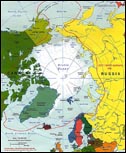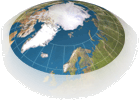 |
Introduction |
| |
Both practitioners and scholars have
long viewed the high latitudes of the Northern Hemisphere - roughly
the Arctic Ocean and the lands and seas surrounding it down to about
60oN- as constituting an area that does not lend itself to effective
international cooperation and for two distinct reasons. Most readers
will hardly need to be reminded that the Arctic was split into two
opposing camps by the Cold War with the Soviet Union on one side
controlling almost half the region, the NATO alliance (including
Denmark/Greenland, Iceland and Norway as well as the United States
and Canada) on the other side, and Finland and Sweden maintaining
a posture of neutrality in between. |

Geo-political map of the Circumpolar area. |
In this context, the region figured
largely as an arena or theater for the deployment of military forces,
including nuclear weapons mounted on bombers and ballistic missiles
carried by nuclear-powered submarines, rather than as a bridge to
be used in promoting international cooperation [1].
Less well known but equally important is the fact that most Arctic
lands and seas have long been treated as peripheries of countries
whose cores and associated policymaking apparatus are located well
to the south [2]. Whether the issues
center on the exploitation of natural resources or the treatment
of indigenous peoples, Moscow has controlled the Russian Arctic,
Copenhagen has ruled Greenland, Ottawa has governed the Canadian
Arctic, and Washington has made policy decisions for Alaska.Given
the resultant pattern of North/South interactions, it is not surprising
that there is no tradition of conceptualizing the Circumpolar North
as a distinct region, much less as a suitable area for initiating
and encouraging the development of productive international relationships.Yet
these conditions have changed both rapidly and dramatically during
the last ten to fifteen years. The winding down of the Cold War
beginning in the late 1980s released a flood of efforts to launch
cooperative ventures that cut across the boundaries of national
jurisdictions in the Far North. What is more, the devolution of
authority from central governments to local/regional governments
in such forms as the creation of the North Slope Borough in Alaska
(1972), the formation of the Greenland
Home Rules (1979), and most recently the establishment of Nunavut
in the Canadian Arctic (1999) has served to increase the capacity
of northerners to interact with one another along East/West lines
rather than being confined to interactions with political and administrative
centers to the South [3]. The emergence
of the Inuit
Circumpolar Conference (ICC) linking the Inuit of Greenland,
Canada, Alaska, and the Russian Far East is simply one prominent
example of this development. |
| |
What can we say about the character
of the landscape of international cooperation that has arisen in
the Arctic in recent years? Do the individual initiatives of a variety
of groups form a coherent whole? Can we now describe the Arctic
accurately as a distinct region in international society? |
| |
This essay addresses these questions,
providing some preliminary answers and laying out a range of issues
relating to international cooperation in the Arctic that require
more systematic consideration. |
|

